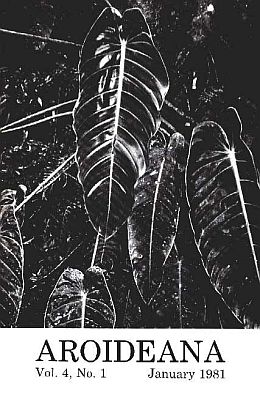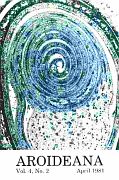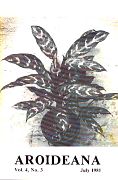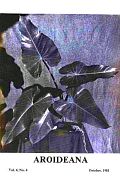|
|



Your search for articles published in volume 4 has found 24 articles.

|

| 
| 
| 
|
Articles of 3 pages or less are available for free to IAS members for download, and longer articles for $5. Articles from issues in 2016 and beyond are only available electronically, and are free to current members when they are logged in.
Please remember that all Aroideana articles are protected by copyright, and you may NOT distribute even electronic copies without permission from the authors or editor.
(Issue) |
||||
| Fred Dortort | Aroids in Costa Rican Gardens (Buy) | |||
| ABSTRACT: During our trip to Costa Rica (see Vol. 3, No.2) we visited some local gardens in conjunction with our ventures into the native forest. We spent some time in two of the botanical gardens, the Jardin Lankester and Las Cruces Tropical Botanical Garden, as well as some private gardens. Both of the botanical gardens have good collections of aroids along with many other tropical plants, and their natural and quasi-natural settings enable many of the aroids to grow to sizes that we rarely see in plants cultivated in containers. | ||||
| S. J. Mayo | A new species of Philodendron from Trinidad
This article available FREE to IAS Members with a PERSONAL login. LOGIN, REGISTER or JOIN | |||
| ABSTRACT: Philodendron simmondsii Mayo sp. nov. is described. | ||||
| Dan H. Nicholson | The gender of Lysichiton Schott (Araceae)
This article available FREE to IAS Members with a PERSONAL login. LOGIN, REGISTER or JOIN | |||
| ABSTRACT: Generic names sometimes exist in several spellings and it becomes a matter of debate to decide which spelling is to be accepted, particularly if more than one spelling is used in the original publication. It is a fact that Schott's first two publications (1857, 1858) used both Lysichitum and Lysichiton but in subsequent publications Schott used only Lysichiton. | ||||
| K. Christiana Figueres | Colocasia esculenta in the Pacific (Buy) | |||
| ABSTRACT: Colocasia is a native of the low wetlands of tropical South East Asia, but is now being cultivated throughout Polynesia, Melanesia, Indonesia, Egypt and tropical America. The wide diffusion of the plant has made it acquire many local names; among others : "talo" or "dalo" in the South Pacific, "kalo" in Hawaii, "taro" in tropical America, "nampi" in Central America, and "coco-yam" in the West Indies. | ||||
| Josef Bogner | Pseudohydrosme gabunensis Engl. (Buy) | |||
| ABSTRACT: The genus Pseudohydrosme was described by Engler (1892) from incomplete material with two species native in Gabon: P. gabunensis Engl. and P. buettneri Engl. During my collecting trip to Gabon in the year 1973, I especially looked for these species and I scheduled my visit to coincide with the flowering time of the two aroids, but they are so rare that I only found two specimens of P. gabunensis. | ||||
| Anonymous | Aroid literature
This article available FREE to IAS Members with a PERSONAL login. LOGIN, REGISTER or JOIN | |||
| ABSTRACT: Jervis, Roy N., Aglaonema Grower's Notebook, revised edition, 1980. iv + 64 pp. Clearwater, Florida. Ohashi, H., and J. Murata, The Taxonomy of the Japanese Arisaema (Araceae), Univ. of Tokyo, J. of Fac. of Science, Sect. III, 12: 281-336 (1980).Siebels, Grenville. 1980. Handbook on Orchid Photography. American Orchid Society, Cambridge. 83 pp. Ill. $5.95, softcover.French, J. C., and P. B. Tomlinson Preliminary observations on the vascular system in stems of certain Araceae, in C. D. Brickell et aI., (eds) Petaloid Monocotyletons Linnean Society Symposium Se: ries No.8, 1980:105-116. are reviewed. | ||||
| Josef Bogner | Amorphophallus titanum (Becc.) Becc. ex Arcangeli (Buy) | |||
| ABSTRACT: The biggest flower in the plant kingdom is produced by the parasitic Rafflesia (Rafflesiaceae), which · can reach up to nearly 1 m in diameter; this genus is distributed in Southeast Asia. The biggest inflorescences (consisting of many single flowers) are probably in the palms and, depending on how one looks at it, the bamboos. But the genus Amorphophallus of the aroids has the biggest unbranched inflorescences in the plant kingdom. | ||||
| Mark D. Moffler | Anthurium araliifolium
This article available FREE to IAS Members with a PERSONAL login. LOGIN, REGISTER or JOIN | |||
| ABSTRACT: I obtained A. araliifolium from the Marie Selby Botanical Gardens in 1978 (Fig. 1, a.,b.). Since this Anthurium is seldom encountered in collections and certainly has horticultural merit (at least for aroid collectors), my thoughts turned to propagation. When I obtained A. araliifolium, three spadices were developing and I decided to self pollinate the flowers in order to have many seeds of this fine plant. | ||||
| Josef Bogner | A new Aridarum species from Borneo (Buy) | |||
| ABSTRACT: Aridarum annae Bogner, sp. nov. is described. | ||||
| C. Sathish Kumar, Dan H. Nicholson | A new species of Theriophonum Bl. (Araceae) from India (Buy) | |||
| ABSTRACT: Theriophonum fischeri Sivadasan, sp. nov. is described. | ||||
| Michael Madison | Packing and shipping aroids
This article available FREE to IAS Members with a PERSONAL login. LOGIN, REGISTER or JOIN | |||
| ABSTRACT: With modem air travel reducing shipping time to a day or two, the success rate of transporting aroids is much improved, but many plants are still killed by improper shipping. The problems mostly have to do with correct preparation and packaging. | ||||
| Zacarias B. Sarian | Short communications
This article available FREE to IAS Members with a PERSONAL login. LOGIN, REGISTER or JOIN | |||
| Monore Birdsey | Editor's corner
This article available FREE to IAS Members with a PERSONAL login. LOGIN, REGISTER or JOIN | |||
| Haruyuki Kamemoto | Anthurium breeding in Hawaii (Buy) | |||
| ABSTRACT: Anthurium andraeanum Linden ex Andre was introduced into Hawaii from London by S. M. Damon in 1889. The spathe color of the first introduction was shellpink. Plants were cultivated in the Damon Estate in Moanalua, Oahu, and by the 1930's had been distributed to other estates, nurseries and hobbyists. Dissemination up to that time was relatively slow due to the inherently slow rate of vegetative propagation of anthuriums. In the late 1930's and 1940's growers had learned to propagate anthuriums from seeds. This resulted in the widespread cultivation of this species and its variants in Hawaii. The novel, exotic, attractive and long-lasting anthurium inflorescences began to appear with regularity in local flower shops. | ||||
| Josef Bogner | A new Dracontium from Mato Grosso (Buy) | |||
| ABSTRACT: Dracontium margaretae Bogner sp. nov. is described. | ||||
| Thomas B. Croat | Propagation of Anthurium cuttings
This article available FREE to IAS Members with a PERSONAL login. LOGIN, REGISTER or JOIN | |||
| ABSTRACT: Recent improvement in the success of propagation techniques employed for general aroid collections prompts me to pass on the information to other members. Though I was not trained as a horticulturist, my trial and error procedures in the establishment of thousands of newly introduced aroids over the course of several years has of necessity educated me. Although I am still not satisfied with my loss rate, there has been so much improvement that I feel compelled to pass on this information in hopes of inducing others to report on successful propagation techniques. | ||||
| Anonymous | A portfolio of photographs from the collection of Roberto Burle-Marx (Buy) | |||
| Anonymous | Errata
This article available FREE to IAS Members with a PERSONAL login. LOGIN, REGISTER or JOIN | |||
| Monore Birdsey | Editor's corner
This article available FREE to IAS Members with a PERSONAL login. LOGIN, REGISTER or JOIN | |||
| Prof. Dr. W. Barthlott, Josef Bogner | Rediscovery of Amorphophallus staudtii (Engl.) N. E. Br. in the Tai National Park (Buy) | |||
| ABSTRACT: The genus Amorphophallus Bl. ex Decne. is distributed in the palaeotropics with nearly one hundred species. One very rare taxon, Amorphophallus staudtii (Engl.) N.E.Br. wasrediscovered by the first author (W .B.) in the Ivory Coast 81 years after the first and only collection in the Cameroons. A detailed description and illustrations of the species and its natural habitat are given. | ||||
| Marcel Lecoufle | Caladium humboldtii and its cultivar 'Marcel'
This article available FREE to IAS Members with a PERSONAL login. LOGIN, REGISTER or JOIN | |||
| ABSTRACT: Caladium humboldtii is the smallest species in the genus. Its showy effect comes from the extreme whiteness of the leaf markings which contrast with the dark green and light green. The height of the plant is normally 18 centimeters, some attaining as much as 25 centimeters. This species was cultivated in enormous quantities in the last century in France, Belgium and England. Florists used it in large quantities for table decorations, and for many kinds of floral arrangements. | ||||
| Arnold Melim | The production of seed by taro
This article available FREE to IAS Members with a PERSONAL login. LOGIN, REGISTER or JOIN | |||
| ABSTRACT: Taro, (Colocasia esculenta (L.) Schott), is a vegetatively propagated crop with many varieties derived through vegetative mutations. Although flowers are produced, several investigators have suggested that taro is sterile, producing no viable seeds or if it does so, rarely. However, more recent reports indicate that seeds can be produced by hand-pollination. The following are my observations and experiences in growing taro seedlings. | ||||
| Anonymous | A series of illustrations from Sodiro (Buy) | |||
| Anonymous | Erratum
This article available FREE to IAS Members with a PERSONAL login. LOGIN, REGISTER or JOIN | |||
All Images and Text © 1996 to 2025 by the International Aroid Society or by their respective owners as noted.
Please send your comments to
served by aws-web2
